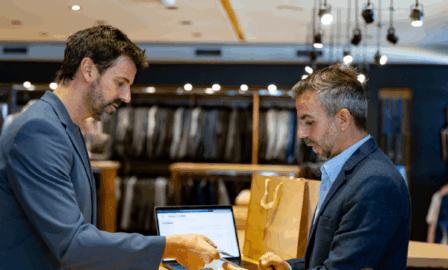Exploring Strategies for Retail Returns in 2024
Particularly in the aftermath of the busy holiday season, shopper returns and product exchanges are abundant in the retail industry. In fact, the NRF estimates 2023 holiday returns to be 15.4%, just above the annual rate of 14.5%. As such, retailers must prioritize efficient reverse logistics, which manages and organizes products from the point of consumption back to the manufacturer. In this piece, we explore how some key strategies for retail returns in 2024.
Strategies for Retail Returns in 2024
A significant contributor to the rising returns rate is the growth of eCommerce. With digital retail, retail returns have become more convenient than ever before. The eCommerce effect on returns can be damaging to profit margins, but sufficiently addressing each return is essential for creating a smooth, enjoyable customer experience.
Moving into 2024 after a busy holiday season – where sales are usually 6.5% higher than other periods throughout the year – retailers are in a prime moment to take advantage of growing sales and returns. Establishing cohesive return logistics will be critical to ensure that customers have a satisfying shopping experience and ultimately ensure retailer profit and success.
Supply Chain Considerations
Retailers seeking to improve their return logistics must find ways to act sustainably and efficiently to benefit both the business and the customer. Developing clear guidelines for the processing of returns and encouraging integration with the inventory management system will offer a smooth post-holiday season for retailers as well as higher customer satisfaction. Real-time visibility, product segmentation, and optimization roadmaps can ensure that goals are clearly outlined and put into motion in the most efficient way possible.
At this year’s NRF’s 2024 Retail’s Big Show conference, retailers and researchers discussed trends in the retail industry, such as AI’s growing role, omnichannel logistics, and online commerce platforms. Reverse logistics have been improved within some companies by taking advantage of AI technologies. For example, Salesforce is using AI technology to analyze returns and inventory, allowing retailers to make real-time strategic decisions about customer preferences and needs.
The NRF Retail’s Big Show conference also discussed how reverse logistics partnerships can allow for a smoother customer return experience. It can be a strategic decision to collaborate with other companies that can manage and check returned items. For example, Kohl’s has integrated Amazon return spots into many of their store locations, which enhanced the convenience of Amazon returns for customers while also drawing more patrons to shop at Kohl’s. A streamlined returns process can reduce retailer costs for processing and management. With the growing return rates of the post-holiday months, it’s critical to manage reverse logistics efficiently to minimize costs and maintain high customer satisfaction.
Logistics from the Customer Standpoint
Retailers must make strategic decisions to enhance the customer experience while also efficiently handling the returned products. Businesses can ease the pressure of such a high volume of retail returns by offering customers multiple convenient options in the reverse logistics process and taking steps to limit unnecessary customer purchases that amplify the number of returns.
One strategy to accomplish this is the idea of peer-to-peer returns. This process involves customers returning unwanted products not to the retailer itself but sending them directly to other customers. Retailers are taking different approaches to this system, with some directly matching customers who are returning a product with customers looking to purchase it. Some retailers are limiting their involvement in this process even more by setting up a marketplace where customers can communicate with one another, and the retailer simply provides the shipping label and information.
Retailers are also looking for ways to combat retailer bracketing, which is when customers purchase several items, usually multiple variations of the same product (different colors, sizes, etc.), with the intent to return all but one. This purchasing behavior can be damaging to retailer inventory and time management as they balance a significantly larger volume of returns. Businesses are working to combat this through third-party returns partnerships and enhanced purchasing features, such as a virtual dressing room to help customers find the right size on the first try.
About 40% of online retailers have implemented a small fee system for customer returns, helping to reframe the costs and benefits of sending products back. By adding a small cost to returns, customers are incentivized to purchase products more intentionally, limiting retail bracketing and decreasing the amount of unnecessary returns. These retailer strategies can help to reduce the volume of unnecessary post-holiday returns and make it easier to manage reverse logistics and customer satisfaction throughout the entire purchase process.
Boosting Sustainability
A high volume of retail returns can also generate significant amounts of waste through the returns packaging and high volume of shipping and transport costs. Retailers can implement new strategies to boost their environmental sustainability while also catering to the customer’s desire for convenience and ease.
Consolidation of packaging can be an effective strategy to manage transportation and packaging waste. This can help reduce costs for retailers and contribute to a positive, eco-friendly company reputation. Companies like Amazon offer consolidation packaging for larger orders, reducing the packaging used for multiple products as well as transportation costs.
Retailers with the capability to reuse and recycle products can also develop sustainable returns practices to reduce costs and environmental impact. Companies can effectively reuse their assets, minimizing product and therefore profit loss. Recycling products also generates significantly less waste than when products end up in the landfill, encouraging a positive environmental impact. Finding ways to boost the sustainability of your return logistics can be effective from both an economic and environmental perspective.
Improving Your Reverse Logistics
To tackle the high volume of product returns as we move into 2024, retailers must streamline their reverse logistics operations for the benefit of both the business and the customer. Consider implementing third-party logistics, as well as shipping consolidation strategies, to manage the high volume of returns and the waste and profit loss that is often associated with it.
To learn more about how to improve the efficiency and sustainability of your company’s reverse logistics, contact our retail experts today.
Subscribe to Clarkston's Insights
Contributions from Samantha Weitzel




